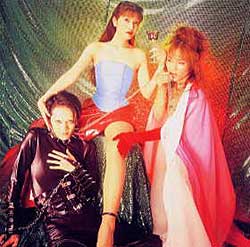by Shizuki Yamashita
|
Along the Chuoh Line in the Tokyo metropolitan area there is a quiet city called Mitaka. Stepping out of the train station, I spot a slender man with yellow highlights in his hair. Kunihiko Ikuhara, the director of hit TV series "Sailor Moon" and "Revolutionary Girl Utena," trots over to greet me. Over the course of year 2000 he introduced himself to thousands of fans at six conventions in North America, where "Sailor Moon" especially has enjoyed a tremendous success (and has inspired countless enthusiasts, young girls and large hairy men alike, to don the uniforms of the Sailor senshi for cosplay). At these conventions Ikuhara earned a reputation for flamboyance, one particularly bold outfit consisted of a bright red shirt, bright blue tie and pink socks. Meeting me in Mitaka for this interview, Ikuhara wore slighty less conspicuous clothing: a red turtleneck, slacks and a black letterman jacket. The thought struck me that perhaps his loud attire was all a show for the American fans. Of course he did grace the "Schell Bullet" CD cover clad in a leather suit that he claims now, in an on-line interview with SciFi.com this past October, to still have and wear while shopping.
But before I had a chance to speculate further, we made our introductions. Ikuhara then introduced me to Michiko Matsukura, the general manager of Ikuhara's production collective Be-Papas, who had come with him to the station. They told me that we had to stop by the Be-Papas office first before heading off someplace more comfortable to chat. Walking super-briskly through the streets of Mitaka, Ikuhara explains that Be-Papas has moved to a new office, smaller than their previous space, because of his planned move to the U.S. "It's just one room now," he explains. "But there are only three of us working there," he adds to counter any misconceptions that the one room isn't enough space for an internationally famous creative entity. Ikuhara formed Be-Papas in 1996 after he left Toei, where for four years he was involved directorially with "Sailor Moon." The original Be-Papas line up included five people: Ikuhara, who served as director and producer, manga artist Chiho Saito, screenwriter Youji Enokido, character designer Shinya Hasegawa and composer J.A. Seazer. They were primarily brought together to create "Utena" and, consequentially, when the "Utena" movie was released in Japan late last year, they disbanded. The company still exists but it engages in smaller projects such as Ikuhara's Schell Bullet releases and Hasegawa and Enokido's "Shounen-Oh," which ran in Newtype Magazine. Ikuhara, walking nearly half a block ahead, speeds up his pace even more, a wide stride that Matsukura matches deftly. However, I, laden with my LA-wed loyalty to the automobile, try to keep up with an injured gallop. People in Tokyo, maybe all of Japan, walk quickly along the streets, and creative people like Ikuhara are no different in the fast-paced business world milieu of Japan. Or, perhaps, Ikuhara fits into both the category of artist and dealmaker. Or maybe he was in a rush to get paperwork done. One of the reasons for my visit was to aid Ikuhara in preparing to take a sabbatical in the US, a step about which I understand him to be extremely nervous. The five-kilometer walk ends in front of a contemporary but aging European-style building. I raise my camera to snap a photo of the Be-Papas sign on the door. "Oh, if you're going to take a picture, photograph this one instead," Ikuhara says excitedly as he leads me up an austere black iron staircase to Be-Papas inner door. "It's cuter." On the second door hangs another Be-Papas sign featuring a black cat reminiscent of Luna, the black feline companion of "Sailor Moon's" Usagi/Serena. |

